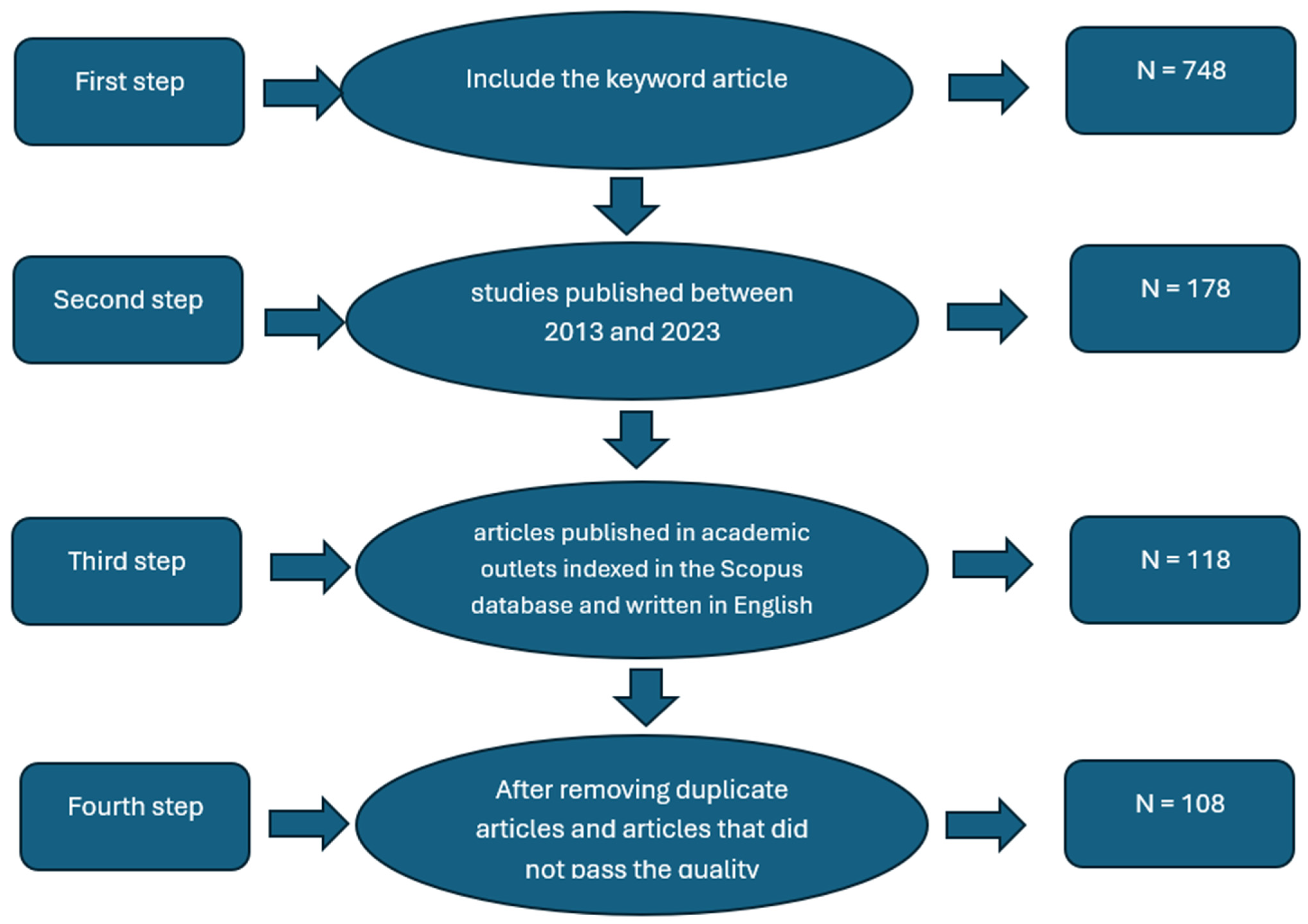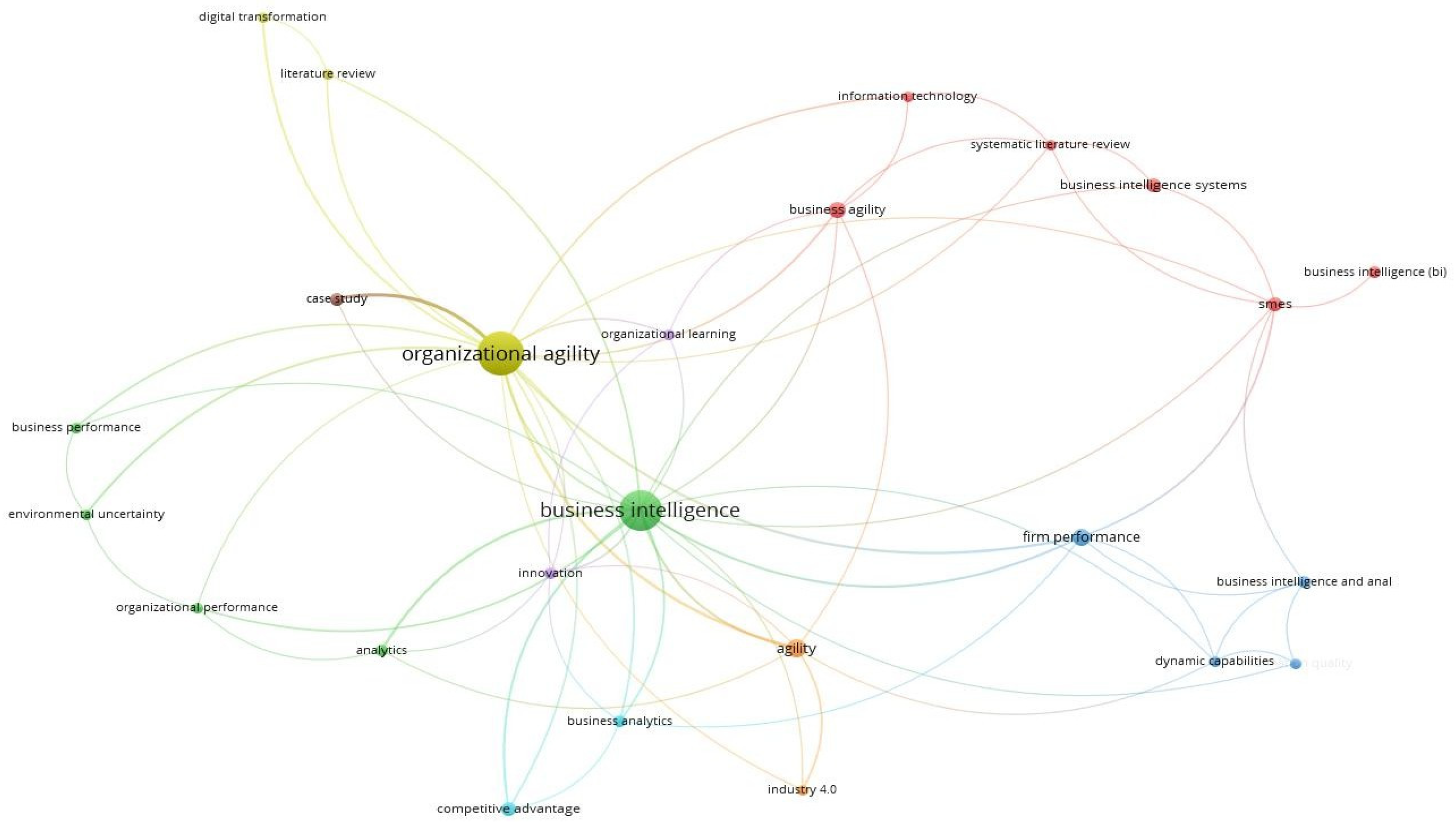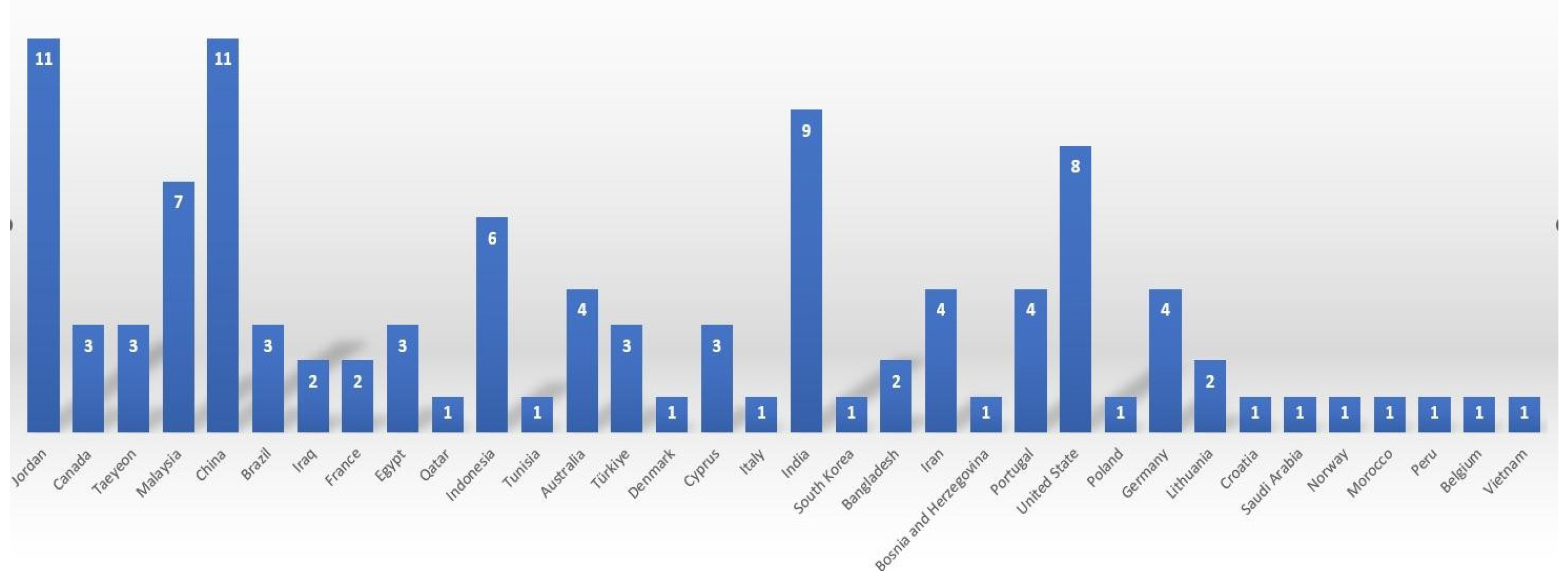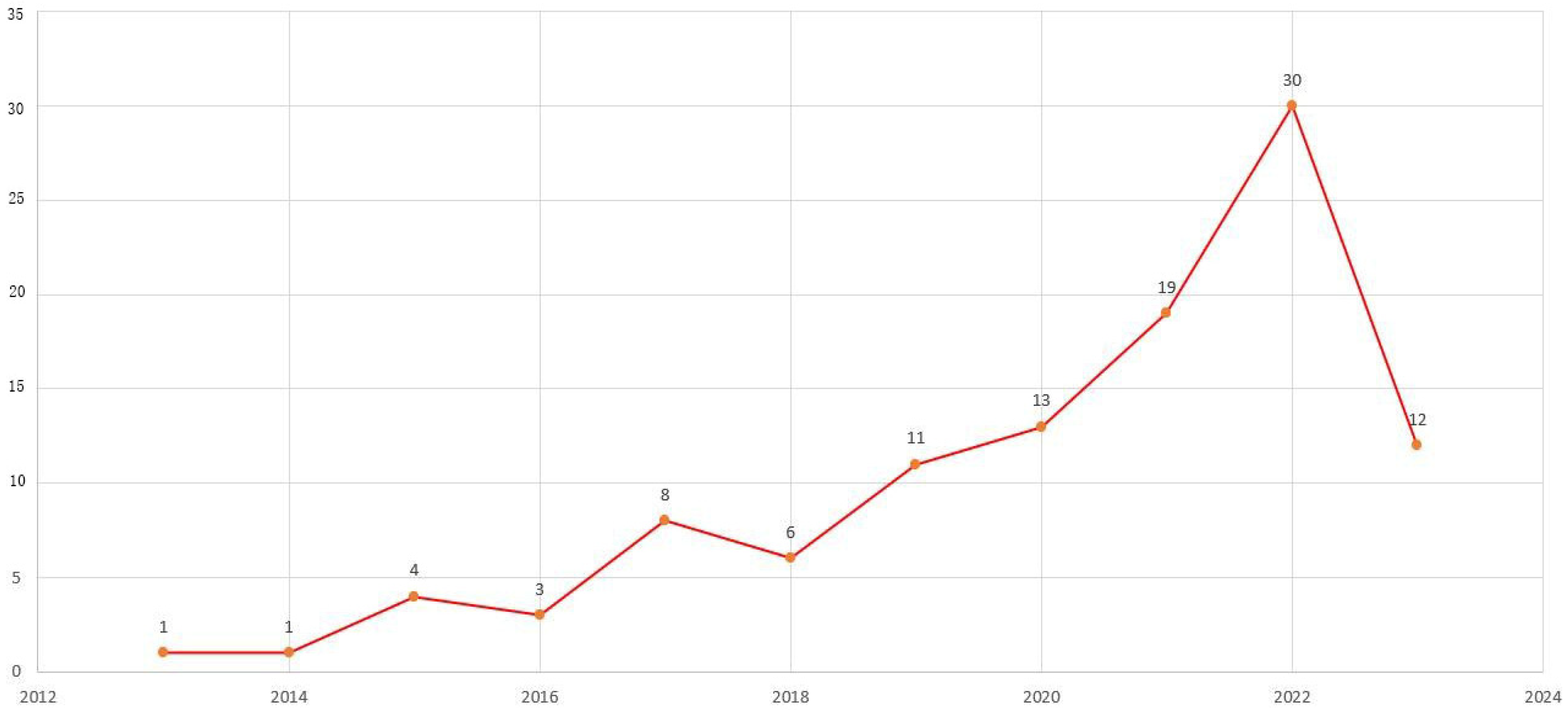A Systematic Literature Review on the Impact of Business Intelligence on Organization Agility
Abstract
1. Introduction
2. Theoretical Background
2.1. Business Intelligence
2.1.1. Benefits of Business Intelligence
2.1.2. Challenges of Business Intelligence
2.2. Organization Agility
2.2.1. Benefits of Organizational Agility
2.2.2. Challenges in Adopting and Implementing Organizational Agility
2.2.3. The Interplay Between Business Intelligence and Organizational Agility
2.3. Research Focus and Scope
3. Research Methodology
3.1. Protocol Development
- Research Question Definition: The research question was “what impact does BI have on OA?” It was used to guide the subsequent stages of the review process.
- Inclusion and Exclusion Criteria: Criteria were established to determine the eligibility of studies for inclusion in the review, ensuring relevance to the research question.
- Data Sources and Search Strategy: The protocol outlined the literature sources to be utilized and the strategy for conducting comprehensive searches to identify relevant studies.
- Quality Assessment: The procedures for assessing the quality of the studies included evaluating the robustness and reliability of their evidence.
- Data Extraction and Synthesis: Guidelines for extracting relevant data from the included studies and synthesizing findings were established to facilitate the analysis process.
3.2. Data Sources and Search Strategy
3.3. Selection and Exclusion Criteria
3.4. Quality Assessment
3.5. Data Mining and Results
- “The Importance of Business Intelligence”;
- “Definition of Business Intelligence”;
- “Definition of Organizational Agility”;
- “Dimensions of Organizational Agility”;
- “Determinants of Organizational Agility”.
4. Discussion and Results
4.1. Relationship Between Business Intelligence and Organizational Agility
4.1.1. Relationship Between Business Intelligence, Innovation, Competitive Advantage, Firm Performance, and Dynamic Capabilities
4.1.2. Impact of Business Intelligence on Organizational Agility
4.2. Studies Related to Business Intelligence and Organizational Agility in the Middle East and North Africa (MENA)
4.3. Distribution of the Studies by Year
5. Conclusions
5.1. Practical Implications
5.2. Limitations and Future Research
Author Contributions
Funding
Institutional Review Board Statement
Informed Consent Statement
Data Availability Statement
Conflicts of Interest
References
- Ahmad, H., Hanandeh, R., Alazzawi, F., Al-Daradkah, A., ElDmrat, A., Ghaith, Y., & Darawsheh, S. (2023). The effects of big data, artificial intelligence, and business intelligence on e-learning and business performance: Evidence from Jordanian telecommunication companies. International Journal of Data and Network Science, 7(1), 35–40. [Google Scholar] [CrossRef]
- Ali, M. D., Miah, S. J., & Khan, S. (2018). Antecedents of business intelligence implementation for addressing organizational agility in small business context. Pacific Asia Journal of the Association for Information Systems, 10(1), 5. [Google Scholar] [CrossRef]
- Al-Omoush, K. S. (2021). The role of top management support and organizational capabilities in achieving e-business entrepreneurship. Kybernetes, 50(5), 1163–1179. [Google Scholar] [CrossRef]
- Anderson, P. (1999). Complexity theory and organization science. Organization Science, 10(3), 216–232. [Google Scholar] [CrossRef]
- Asgarnezhad Nouri, B., & Mir Mousavi, M. (2020). Effect of cooperative management on organizational agility with the mediating role of employee empowerment in the public transportation sector. Cuadernos de Gestión, 20(2), 15–45. [Google Scholar] [CrossRef]
- Asseraf, Y., Lages, L. F., & Shoham, A. (2019). Assessing the drivers and impact of international marketing agility. International Marketing Review, 36(2), 289–315. [Google Scholar] [CrossRef]
- Awwad, A. S., Ababneh, O. M., & Karasneh, M. (2022). The mediating impact of IT capabilities on the association between dynamic capabilities and organizational agility: The case of the Jordanian IT sector. Global Journal of Flexible Systems Management, 23(3), 315–330. [Google Scholar] [CrossRef]
- Barlette, Y., & Baillette, P. (2020). Big data analytics in turbulent contexts: Towards organizational change for enhanced agility. Production Planning & Control, 31(15), 1195–1212. [Google Scholar] [CrossRef]
- Barney, J. (1991). Firm resources and sustained competitive advantage. Journal of Management, 17(1), 99–120. [Google Scholar] [CrossRef]
- Božič, K., & Dimovski, V. (2019). Business intelligence and analytics use, innovation ambidexterity, and firm performance: A dynamic capabilities perspective. The Journal of Strategic Information Systems, 28(4), 101578. [Google Scholar] [CrossRef]
- Börjesson, A., & Mathiassen, L. (2005). Improving software organizations: Agility challenges and implications. Information Technology & People, 18(4), 359–382. [Google Scholar]
- Carvalho, A. M., Sampaio, P., Rebentisch, E., & Saraiva, P. (2017, December 10–13). Quality, excellence and culture in the pursuit of organizational agility. 2017 IEEE International Conference on Industrial Engineering and Engineering Management (IEEM) (pp. 1714–1718), Singapore. [Google Scholar]
- Chen, H., Chiang, R. H., & Storey, V. C. (2012). Business intelligence and analytics: From big data to big impact. MIS Quarterly, 36(4), 1165–1188. [Google Scholar] [CrossRef]
- Cheng, C., Zhong, H., & Cao, L. (2020). Facilitating speed of internationalization: The roles of business intelligence and organizational agility. Journal of Business Research, 110, 95–103. [Google Scholar] [CrossRef]
- Cho, H. E., Jeong, I., Kim, E., & Cho, J. (2023). Achieving superior performance in international markets: The roles of organizational agility and absorptive capacity. Journal of Business & Industrial Marketing, 38(4), 736–750. [Google Scholar]
- Dahms, S., Cabrilo, S., & Kingkaew, S. (2023). Configurations of innovation performance in foreign-owned subsidiaries: Focusing on organizational agility and digitalization. Management Decision, 63(6), 1960–1984. [Google Scholar] [CrossRef]
- Darwiesh, A., El-Baz, A. H., Tarabia, A. M. K., & Elhoseny, M. (2022). Business intelligence for risk management: A review. American Journal of Business and Operations Research, 6, 16–27. [Google Scholar] [CrossRef]
- Eidizadeh, R., Salehzadeh, R., & ChitsazEsfahani, A. (2017). Analyzing the role of business intelligence, knowledge sharing and organizational innovation on gaining competitive advantage. Journal of Workplace Learning, 29(4), 250–267. [Google Scholar] [CrossRef]
- Elbashir, M. Z., Collier, P. A., & Davern, M. J. (2008). Measuring the effects of business intelligence systems: The relationship between business process and organizational performance. International Journal of Accounting Information Systems, 9(3), 135–153. [Google Scholar] [CrossRef]
- Felipe, C. M., Leidner, D. E., Roldán, J. L., & Leal-Rodríguez, A. L. (2020). Impact of IS capabilities on firm performance: The roles of organizational agility and industry technology intensity. Decision Sciences, 51(3), 575–619. [Google Scholar] [CrossRef]
- Ferreira, T., Pedrosa, I., & Bernardino, J. (2017). Business intelligence for e-commerce: Survey and research trends. In Recent advances in information systems and technologies (Vol. 1, pp. 215–225). Springer. [Google Scholar]
- Gauzelin, S., & Bentz, H. (2017). An examination of the impact of business intelligence systems on organizational decision-making and performance: The case of France. Journal of Intelligence Studies in Business, 7(2), 40–50. [Google Scholar] [CrossRef]
- GhalichKhani, R. D., & Hakkak, M. (2016). A Model for measuring the direct and indirect impact of business intelligence on organizational agility with partial mediatory role of empowerment (Case study: Tehran construction engineering organization (TCEO) and ETKA organization industries. co). Procedia-Social and Behavioral Sciences, 230, 413–421. [Google Scholar] [CrossRef]
- Goldman, S. L., Nagel, R. N., & Preiss, K. (1995). Agile competitors and virtual organizations. Manufacturing Review, 8(1), 59–67. [Google Scholar][Green Version]
- Haider, S. A., Tehseen, S., Khan, S., Mata, M. N., Martins, J. M., & Abreu, A. (2021). A literature review on agility-is there a need to develop a new instrument? International Journal of Entrepreneurship, 25(4), 1–14. [Google Scholar][Green Version]
- Hamad, F., Al-Aamr, R., Jabbar, S. A., & Fakhuri, H. (2021). Business intelligence in academic libraries in Jordan: Opportunities and challenges. IFLA Journal, 47(1), 37–50. [Google Scholar] [CrossRef]
- Hyun, Y., Park, J., Kamioka, T., & Chang, Y. (2023). Organizational agility enabled by big data analytics: Information systems capabilities view. Journal of Enterprise Information Management, 36(4), 1032–1055. [Google Scholar] [CrossRef]
- Jayampathi, E. K., De Alwis, A. C., & Razi, M. J. M. (2022). Role of organizational agility in knowledge management orientation and organizational performance: A systematic literature review. Wayamba Journal of Management, 13(1), 1–27. [Google Scholar] [CrossRef]
- Khaddam, A. A., Alzghoul, A., Abusweilem, M. A., & Abusweilem, F. (2021). Business intelligence and firm performance: A moderated-mediated model. The Service Industries Journal, 41(1), 1–17. [Google Scholar] [CrossRef]
- Khan, A., Talukder, M. S., Islam, Q. T., & Islam, A. N. (2022). The impact of business analytics capabilities on innovation, information quality, agility and firm performance: The moderating role of industry dynamism. VINE Journal of Information and Knowledge Management Systems, 54(5), 1124–1152. [Google Scholar] [CrossRef]
- Kiani Mavi, R., & Standing, C. (2018). Cause and effect analysis of business intelligence (BI) benefits with fuzzy DEMATEL. Knowledge Management Research & Practice, 16(2), 245–257. [Google Scholar]
- Kitchenham, B. (2004). Procedures for performing systematic reviews. Keele University. [Google Scholar]
- Kitchenham, B. A., Brereton, O. P., Budgen, D., Turner, M., Bailey, J., & Linkman, S. (2009). Systematic literature reviews in software engineering—A systematic literature review. Information and Software Technology, 51(1), 7–15. [Google Scholar] [CrossRef]
- Knabke, T., & Olbrich, S. (2018). Building novel capabilities to enable business intelligence agility: Results from a quantitative study. Information Systems and e-Business Management, 16(3), 493–546. [Google Scholar] [CrossRef]
- Kurniawana, R., & Hamsalb, I. M. (2019). Achieving decision-making quality and organizational agility in innovation portfolio management in telecommunication 4.0. International Journal of Innovation, Creativity and Change, 8(6), 332–356. [Google Scholar]
- Lawrence, P. R., & Lorsch, J. W. (1967). Differentiation and integration in complex organizations. Administrative Science Quarterly, 12(1), 1–47. [Google Scholar] [CrossRef]
- Liu, S., Chan, F. T., Yang, J., & Niu, B. (2018). Understanding the impact of cloud computing on organizational agility: An empirical examination. International Journal of Information Management, 43, 98–111. [Google Scholar] [CrossRef]
- Llave, M. R. (2017). Business intelligence and analytics in small and medium-sized enterprises: A systematic literature review. Procedia Computer Science, 121, 194–205. [Google Scholar] [CrossRef]
- Ludviga, I., & Kalvina, A. (2023). Organizational agility during crisis: Do employees’ perceptions of public sector organizations’ strategic agility foster employees’ work engagement and well-being? Employee Responsibilities and Rights Journal, 36(2), 209–229. [Google Scholar] [CrossRef]
- Mbima, D., & Tetteh, F. K. (2023). Effect of business intelligence on operational performance: The mediating role of supply chain ambidexterity. Modern Supply Chain Research and Applications, 5(1), 28–49. [Google Scholar] [CrossRef]
- Mikalef, P., Pappas, I. O., Krogstie, J., & Giannakos, M. (2018). Big data analytics capabilities: A systematic literature review and research agenda. Information Systems and e-Business Management, 16(3), 547–578. [Google Scholar] [CrossRef]
- Mrugalska, B., & Ahmed, J. (2021). Organizational agility in industry 4.0: A systematic literature review. Sustainability, 13(15), 8272. [Google Scholar] [CrossRef]
- Nambisan, S., Lyytinen, K., Majchrzak, A., & Song, M. (2017). Digital innovation management: Reinventing innovation management research in a digital world. MIS Quarterly, 41(1), 223–238. [Google Scholar] [CrossRef]
- Nazari, F., Taghavi, S. S., Valizadeh, E., Soleymani, M., Farahani, D. S., & Bagheri, R. (2022). An investigation on the impact of business intelligence over the performance of startup companies according to innovation and knowledge management as mediators. Mathematical Problems in Engineering, 2022, 3834696. [Google Scholar] [CrossRef]
- Niwash, M. N. K., Cek, K., & Eyupoglu, S. Z. (2022). Intellectual capital and competitive advantage and the mediation effect of innovation quality and speed, and business intelligence. Sustainability, 14(6), 3497. [Google Scholar] [CrossRef]
- Nurcholis, L. (2021). The mediating effect of knowledge exploitation and organizational agility on the relationship between marketing adaptation strategy and sustainable competitive advantage. Contaduría y Administración, 66(1), 1–23. [Google Scholar]
- Obidat, A., Alziyadat, Z., & Alabaddi, Z. (2023). Assessing the impact of business intelligence on supply chain agility. A perspective from the Jordanian manufacturing sector. Uncertain Supply Chain Management, 11(1), 61–70. [Google Scholar] [CrossRef]
- Page, M. J., McKenzie, J. E., Bossuyt, P. M., Boutron, I., Hoffmann, T. C., Mulrow, C. D., Shamseer, L., Tetzlaff, C. W., Akl, E. A., Brennan, S. E., Chou, R., Glanville, J., Grimshaw, J. M., Hróbjartsson, A., Lalu, M. M., Li, T., Loder, E. W., Mayo-Wilson, E., McDonald, S., … Moher, D. (2021). The PRISMA 2020 statement: An updated guideline for reporting systematic reviews. BMJ, 372, n71. [Google Scholar] [CrossRef]
- Paradza, D., & Daramola, O. (2021). Business intelligence and business value in organizations: A systematic literature review. Sustainability, 13(20), 11382. [Google Scholar] [CrossRef]
- Park, Y., El Sawy, O. A., & Fiss, P. (2017). The role of business-intelligence and communication technologies in organizational agility: A configurational approach. Journal of the Association for Information Systems, 18(9), 1. [Google Scholar] [CrossRef]
- Patel, B. S., & Sambasivan, M. (2022). A systematic review of the literature on supply chain agility. Management Research Review, 45(2), 236–260. [Google Scholar] [CrossRef]
- Qosasi, A., Permana, E., Muftiadi, A., Purnomo, M., & Maulina, E. (2019). Building SMEs’ competitive advantage and the organizational agility of apparel retailers in Indonesia: The role of ICT as an initial trigger. Gadjah Mada International Journal of Business, 21(1), 69–90. [Google Scholar] [CrossRef]
- Ranjan, J., & Foropon, C. (2021). Big data analytics in building the competitive intelligence of organizations. International Journal of Information Management, 56, 102231. [Google Scholar] [CrossRef]
- Reeves, M., Zeng, M., & Venjara, A. (2015). The self-tuning enterprise. Harvard Business Review, 93(6), 77–83. [Google Scholar]
- Sambamurthy, V., Bharadwaj, A., & Grover, V. (2003). Shaping agility through digital options: Reconceptualizing the role of information technology in contemporary firms. MIS Quarterly, 27(2), 237–263. [Google Scholar] [CrossRef]
- Shen, C. C., Chang, R. E., Hsu, C. J., & Chang, I. C. (2017). How business intelligence maturity enables hospital agility. Telematics and Informatics, 34(1), 450–456. [Google Scholar] [CrossRef]
- Skyrius, R., & Valentukevičė, J. (2020). Business intelligence agility, informing agility and organizational agility: Research agenda. Information & Media, 90, 8–25. [Google Scholar]
- Strode, D. E., Sharp, H., Barroca, L., Gregory, P., & Taylor, K. (2022). Tensions in organizations transforming to agility. IEEE Transactions on Engineering Management, 69(6), 3572–3583. [Google Scholar] [CrossRef]
- Teece, D. J. (2007). Explicating dynamic capabilities: The nature and microfoundations of (sustainable) enterprise performance. Strategic Management Journal, 28(13), 1319–1350. [Google Scholar] [CrossRef]
- Teece, D. J., Pisano, G., & Shuen, A. (1997). Dynamic capabilities and strategic management. Strategic Management Journal, 18(7), 509–533. [Google Scholar] [CrossRef]
- Wahyudi, W., Sulistyowati, P., Iriyanto, S., Poerbantor, H., & Sukamto, S. (2023). The effects of intellectual capital on organisational agility: The role of knowledge sharing as mediation. International Journal of Economics and Management Research, 2(1), 9–25. [Google Scholar] [CrossRef]
- Walter, A. T. (2021). Organizational agility: Ill-defined and somewhat confusing? A systematic literature review and conceptualization. Management Review Quarterly, 71(2), 343–391. [Google Scholar] [CrossRef]
- Wamba, S. F. (2022). Impact of artificial intelligence assimilation on firm performance: The mediating effects of organizational agility and customer agility. International Journal of Information Management, 67, 102544. [Google Scholar] [CrossRef]
- Werder, K., Richter, J., Hennel, P., Dreesen, T., Fischer, M., & Weingarth, J. (2021). A three-pronged view on organizational agility. IT Professional, 23(2), 89–95. [Google Scholar] [CrossRef]
- Wilden, R., Akaka, M. A., Karpen, I. O., & Hohberger, J. (2017). The evolution and prospects of service-dominant logic: An investigation of past, present, and future research. Journal of Service Research, 20(4), 345–361. [Google Scholar] [CrossRef]
- Worley, C. G., Williams, T., & Lawler, E. E., III. (2014). The agility factor: Building adaptable organizations for superior performance. Jossey-Bass. [Google Scholar]
- Xiao, Y., & Watson, M. (2019). Guidance on conducting a systematic literature review. Journal of Planning Education and Research, 39(1), 93. [Google Scholar] [CrossRef]
- Yan, K., Xia, E., Li, J., & Huang, J. (2023). Assessing the impact of business intelligence quality on enterprise innovation performance: A knowledge dynamic capability perspective. International Journal of Technology Management, 92(1–2), 112–138. [Google Scholar] [CrossRef]
- Zamba, C. R., Mahlangu, G., Giyane, M., & Rebanowako, T. G. (2018). An investigation of the potential benefits and challenges of business intelligence adoption in the retail sector in Gweru, Zimbabwe. Journal of Systems Integration, 9(2), 20–25. [Google Scholar]
- Zoubi, M., Alfaris, Y., Fraihat, B., Otoum, A., Nawasreh, M., & Alfandi, A. (2023). An extension of the diffusion of innovation theory for business intelligence adoption: A maturity perspective on project management. Uncertain Supply Chain Management, 11(2), 465–472. [Google Scholar] [CrossRef]




| Study | Country | Sector | BI Tool | Key Outcome | OA Dimension |
|---|---|---|---|---|---|
| Awwad et al. (2022) | Jordan | IT | BI systems | Performance | Flexibility |
| Obidat et al. (2023) | Jordan | Manufacturing | Data warehousing | Supply chain agility | Responsiveness |
| Criteria | Inclusion | Exclusion |
|---|---|---|
| Publication type | Research papers published in reputable academic journals | Conference proceedings, books, dissertations, ongoing research, seminars, |
| Temporal scope | Articles published between 2013 and 2023 | Articles published before 2013 |
| Study focus | Studies investigating the impact of business intelligence (BI) on organizational agility (OA) | Studies that did not focus on BI’s impact on OA |
| Language | Articles written in English | Articles written in a language other than English |
Disclaimer/Publisher’s Note: The statements, opinions and data contained in all publications are solely those of the individual author(s) and contributor(s) and not of MDPI and/or the editor(s). MDPI and/or the editor(s) disclaim responsibility for any injury to people or property resulting from any ideas, methods, instructions or products referred to in the content. |
© 2025 by the authors. Licensee MDPI, Basel, Switzerland. This article is an open access article distributed under the terms and conditions of the Creative Commons Attribution (CC BY) license (https://creativecommons.org/licenses/by/4.0/).
Share and Cite
Malawani, L.; Sanguinoa, R.; Tato Jiménez, J.L. A Systematic Literature Review on the Impact of Business Intelligence on Organization Agility. Adm. Sci. 2025, 15, 250. https://doi.org/10.3390/admsci15070250
Malawani L, Sanguinoa R, Tato Jiménez JL. A Systematic Literature Review on the Impact of Business Intelligence on Organization Agility. Administrative Sciences. 2025; 15(7):250. https://doi.org/10.3390/admsci15070250
Chicago/Turabian StyleMalawani, Luay, Ramón Sanguinoa, and Juan Luis Tato Jiménez. 2025. "A Systematic Literature Review on the Impact of Business Intelligence on Organization Agility" Administrative Sciences 15, no. 7: 250. https://doi.org/10.3390/admsci15070250
APA StyleMalawani, L., Sanguinoa, R., & Tato Jiménez, J. L. (2025). A Systematic Literature Review on the Impact of Business Intelligence on Organization Agility. Administrative Sciences, 15(7), 250. https://doi.org/10.3390/admsci15070250





